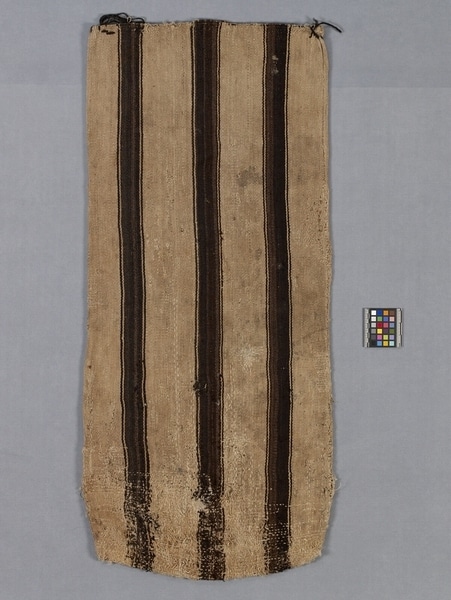Bag Item Number: Sf991 from the MOA: University of British Columbia


Description
Bag, rectangular, with three dark brown vertical bands each flanked by two narrow stripes on a light brown background. Four yarn lengths are attached at the mouth for closing the sack.
History Of Use
Warp-faced fabrics with three or four selvedges are woven by women on the indigenous style loom, a staked-out horizontal ground loom, or an adjustable tension (body) loom. The technique and structure have pre-Conquest antecedents, and as in ancient times, the fabrics are used in their rectangular form without cutting or shaping. Striped woven sacks are the traditional containers for trading between areas of different altitude. They are also used for storing and carrying crops locally. Weavers use them to sit on or to spread beneath the ground loom and to store textiles in the house.
Specific Techniques
Plain colour areas or stripes are warp-faced plain weave. Sheep's wool is z-spun and plied s; warp faced plain weave; construction is folded and sewing; running stitch used for side seams and closely spaced overcastting makes a ridged edging along the seam. The bottom of the bag has been darned many times. Extra yarns are crudely attached to the mouth for a closure.
Cultural Context
Agriculture, domestic.
Narrative
Sold by Esteban Huatta Cruz but made by his mother-in-law, Josepha Huatta Yucra. Used by the men of the family to carry beans, corn and potatoes down from their fields. 50 kilos can be carried on their backs with one hand on each upper corner.
Item History
- Made by Josepha Huatta Yucra (Maker) in Taquile, Puno, Peru during 1956
- Collected by Elizabeth L. Johnson during 1984
- Owned by Elizabeth L. Johnson before June 13, 1984
- Received from Elizabeth L. Johnson (Seller) and Museum of Anthropology Shop Volunteers (Funding source) on June 13, 1984
What
Who
- Culture
- Quechua
- Creator
- Josepha Huatta Yucra (Maker)
- Field Collector
- Elizabeth L. Johnson
- Previous Owner
- Elizabeth L. Johnson
- Received from
- Elizabeth L. Johnson (Seller) and Museum of Anthropology Shop Volunteers (Funding source)
Where
- Holding Institution
- MOA: University of British Columbia
- Made in
- Taquile, Puno, Peru
When
- Creation Date
- during 1956
- Collection Date
- during 1984
- Ownership Date
- before June 13, 1984
- Acquisition Date
- on June 13, 1984
Other
- Item Classes
- textiles
- Condition
- poor
- Accession Number
- 0992/0019